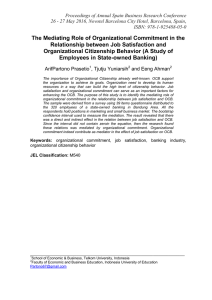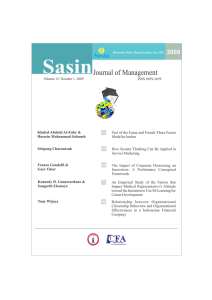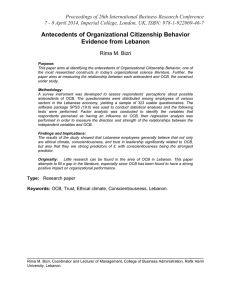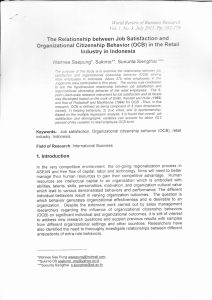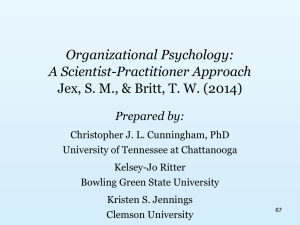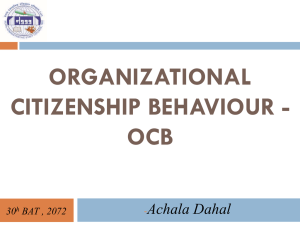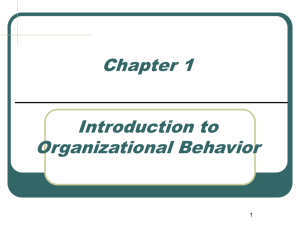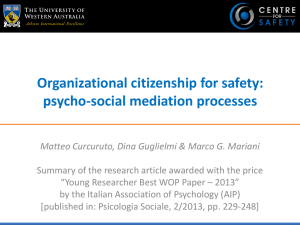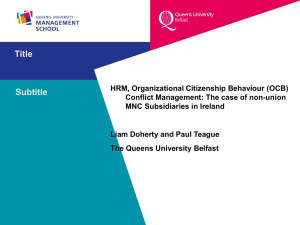Asian Journal of Business Management 3(2): 91-97, 2011 ISSN: 2041-8752
advertisement
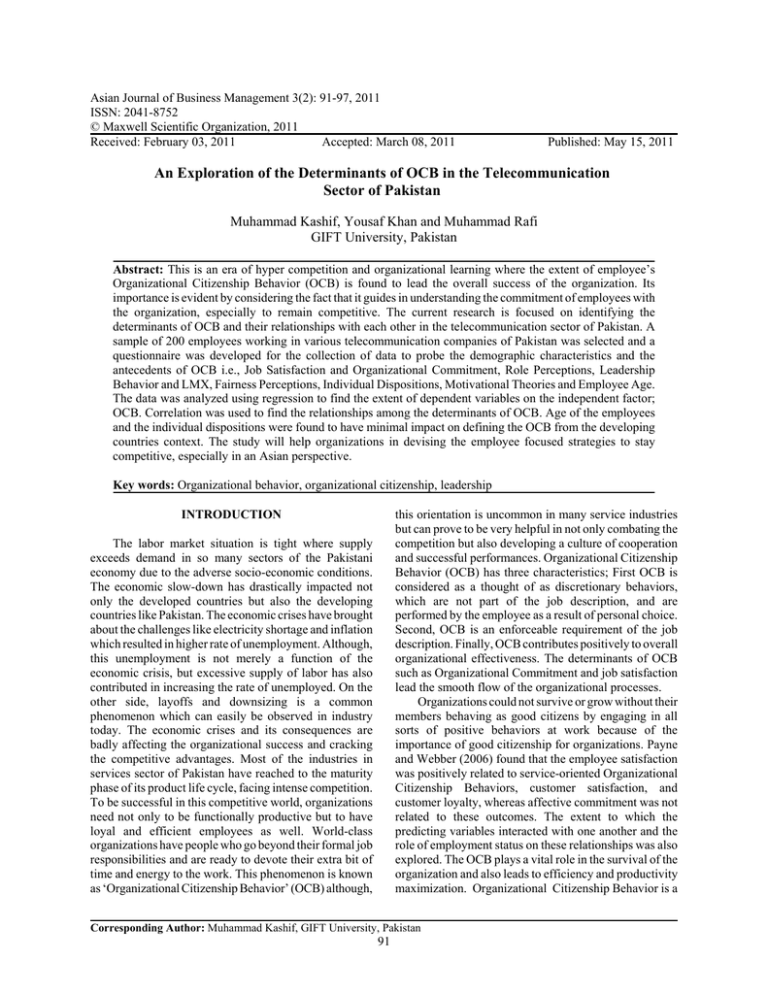
Asian Journal of Business Management 3(2): 91-97, 2011 ISSN: 2041-8752 © Maxwell Scientific Organization, 2011 Received: February 03, 2011 Accepted: March 08, 2011 Published: May 15, 2011 An Exploration of the Determinants of OCB in the Telecommunication Sector of Pakistan Muhammad Kashif, Yousaf Khan and Muhammad Rafi GIFT University, Pakistan Abstract: This is an era of hyper competition and organizational learning where the extent of employee’s Organizational Citizenship Behavior (OCB) is found to lead the overall success of the organization. Its importance is evident by considering the fact that it guides in understanding the commitment of employees with the organization, especially to remain competitive. The current research is focused on identifying the determinants of OCB and their relationships with each other in the telecommunication sector of Pakistan. A sample of 200 employees working in various telecommunication companies of Pakistan was selected and a questionnaire was developed for the collection of data to probe the demographic characteristics and the antecedents of OCB i.e., Job Satisfaction and Organizational Commitment, Role Perceptions, Leadership Behavior and LMX, Fairness Perceptions, Individual Dispositions, Motivational Theories and Employee Age. The data was analyzed using regression to find the extent of dependent variables on the independent factor; OCB. Correlation was used to find the relationships among the determinants of OCB. Age of the employees and the individual dispositions were found to have minimal impact on defining the OCB from the developing countries context. The study will help organizations in devising the employee focused strategies to stay competitive, especially in an Asian perspective. Key words: Organizational behavior, organizational citizenship, leadership this orientation is uncommon in many service industries but can prove to be very helpful in not only combating the competition but also developing a culture of cooperation and successful performances. Organizational Citizenship Behavior (OCB) has three characteristics; First OCB is considered as a thought of as discretionary behaviors, which are not part of the job description, and are performed by the employee as a result of personal choice. Second, OCB is an enforceable requirement of the job description. Finally, OCB contributes positively to overall organizational effectiveness. The determinants of OCB such as Organizational Commitment and job satisfaction lead the smooth flow of the organizational processes. Organizations could not survive or grow without their members behaving as good citizens by engaging in all sorts of positive behaviors at work because of the importance of good citizenship for organizations. Payne and Webber (2006) found that the employee satisfaction was positively related to service-oriented Organizational Citizenship Behaviors, customer satisfaction, and customer loyalty, whereas affective commitment was not related to these outcomes. The extent to which the predicting variables interacted with one another and the role of employment status on these relationships was also explored. The OCB plays a vital role in the survival of the organization and also leads to efficiency and productivity maximization. Organizational Citizenship Behavior is a INTRODUCTION The labor market situation is tight where supply exceeds demand in so many sectors of the Pakistani economy due to the adverse socio-economic conditions. The economic slow-down has drastically impacted not only the developed countries but also the developing countries like Pakistan. The economic crises have brought about the challenges like electricity shortage and inflation which resulted in higher rate of unemployment. Although, this unemployment is not merely a function of the economic crisis, but excessive supply of labor has also contributed in increasing the rate of unemployed. On the other side, layoffs and downsizing is a common phenomenon which can easily be observed in industry today. The economic crises and its consequences are badly affecting the organizational success and cracking the competitive advantages. Most of the industries in services sector of Pakistan have reached to the maturity phase of its product life cycle, facing intense competition. To be successful in this competitive world, organizations need not only to be functionally productive but to have loyal and efficient employees as well. World-class organizations have people who go beyond their formal job responsibilities and are ready to devote their extra bit of time and energy to the work. This phenomenon is known as ‘Organizational Citizenship Behavior’ (OCB) although, Corresponding Author: Muhammad Kashif, GIFT University, Pakistan 91 Asian J. Bus. Manage., 3(2): 91-97, 2011 OCB related activities. Even so, personality may be a vital measure in order to control for its influence on behavior or to examine any moderating effects it may have in citizenship behaviors. The employee’s age and their perceptions towards themselves and their work are different and this phenomenon is not a new paradigm in OB researches. The younger employees align their needs with organizational needs easily and prove to be a little more flexible as compared with their elder counterparts. In contrary, the older employees tend to be more rigid in adjusting their needs with the organizational needs. Therefore, younger and older employees differ in their orientations toward self, others, and their work. These differences although complex, but lead to observing different important motives for OCB among different age groups of employees. Numerous studies on determinants of OCB have been conducted around by different researchers. Organ and Ryan have conducted 28 of those studies; all in different context and culture as compared to the organizational culture of Pakistan. On the other hand, very little work is conducted to understand the theory and practice of OCB from a developing country’s context. This study is an effort to fill this gap by providing a framework to understand the OCB and its application to the Pakistani services sector. newer concept considered in Organizational Behavior discipline, but it has a major share of organizational behavior research. The determinants of OCB are widespread in academic discipline of OB but the current study investigates the OCB construct by using a model of the determinants of OCB defined by Nadim and Muzahid (2004). The factors used in the study are i.e., Job Satisfaction and Organizational Commitment, Role Perceptions, Leadership Behavior and LMX, Fairness Perceptions, Individual Dispositions, Motivational Theories and Employee Age. Job satisfaction plays an important role in contributing towards the OCB and is predominantly linked with work motivation. The Job design aims to enhance the job satisfaction and employee performance. Some of the well-known job design methods include job rotation, job enlargement and job enrichment. Other influences on satisfaction are the management style and culture, employee involvement in work, and empowerment and autonomous work position. Wegge et al. (2006) found that objective working conditions substantially correlated with subjective measures of work motivation, Moreover employees experiencing a high motivating potential at work reported more Organizational Citizenship Behavior, higher job satisfaction, and less turnover intentions. Work not only provides a platform to employees for exhibiting Organizational Citizenship Behavior but also reduces the turnover intension. In these days recruitment is not problem retention is a problem. It can be contrasted with other work-related attitudes, such as job satisfaction, defined as an employee's feelings about the job at hand, and organizational identification; the degree to which the employees experiences a 'sense of oneness' within their organization. Role perceptions or role stressors include perceptions such as role conflict and role ambiguity, both of which have been found to be significantly negatively related to OCBs. More recently, Podsakoff et al. (2010) found that OCBs have a positive relationship with performance ratings and reward allocation. Podsakoff et al. (2010) defined the effects of job candidate’s tendency to exhibit OCBs on selection decisions made in the context of a job interview. These researchers found that candidates whose interview responses indicated a tendency to engage in helping others, challenge the status quo by voicing their opinions, and support and defend an organization were generally viewed as more competent, received higher overall evaluations, and received higher recommended starting salaries as compared to those who were unable to exhibit the same. Personality variables include the feelings like positive affectivity; negative affectivity, conscientiousness, and agreeableness have all been found to predispose people to orientations which make them more likely to engage in LITERATURE REVIEW Organizational citizenship behavior: Organizational Citizenship Behavior (OCB) is defined some extra jobrelated behaviors which go above and beyond the routine duties prescribed by the employee’s job descriptions (Bateman and Organ, 1983). Initially, Katz (1964) introduced the term of OCB on extra role behaviors. Organ and Bateman (1983) further developed into the understanding of this concept of OCB and they concluded in it by calling it “the good soldier syndrome” (Organ, 1988). Organizational Citizenship Behavior impacts workgroup efficiency during the times of crisis (Organ, 1998). By having conscientiousness and willingly helping others results in decreased inter-group conflict, and increase in the motivational level of employees which allows managers to focus on more pressing and important organizational matters (MacKenzie et al., 1999). Organ (1990) suggests that OCB not only adds to employee and organizational performance, but it also changes the way a manager evaluates the employees. In the meantime, the studies in OCB have been very broad since its evolution (Bateman and Organ, 1983). OCB is held to be an important to the survival and well being of an organization Organ (1988). OCB defines a set of desirable organizational behaviors, which illustrate 92 Asian J. Bus. Manage., 3(2): 91-97, 2011 Job Satisfaction & Organization Commitment Role Perecptions Leadership bahaviors & LMX OCB Fairness Perception Individual Dispositions Motivational Theories Employee Age Fig. 1: Antecedents of organizational citizenship behavior, (Nadim and Muzahid, 2004) Meyer, 1996), it would seem logical that emotional commitment drives those behaviors which do not depend primarily on reinforcement through formal rewards. multi-dimensional relationships with positive organizational results (Walz and Niehoff, 1996). In studies, every study supported a new determinant of OCB. Any type of behavior which results in benefiting the organization, is discretionary and goes beyond existing role expectations is referred to as OCB and is very important for organizational success (Van Dyne et al., 1995). Organizational citizenship behavior achieves an increased amount of the output in long term perspective rather than the shorter ones (Joireman et al., 2006). OCB has also been viewed as ‘affinitive and promotive’ set of behaviors that demonstrate the employee’s desire to maintain a relationship with coworkers or the organization by contributing to the organizational success (Van Dyne et al., 1995). Leaders behavior and LMX (Leader member exchange): The quality of the relationship between a subordinate and a leader is often called Leader Member Exchange (LMX). Another component of leadership is positively related to OCB is the leaders' contingent rewards behaviors, such as expressing satisfaction or appreciation for good performance (Podsakoff et al., 2010). Leadership apparently seems to have a strong influence on an employee's willingness to engage in OCBs. Though, somewhat than being associated with a specific leadership style, the quality of an employee's relationship with his or her leader that plays the role and is key to better performance (Podsakoff et al., 2010). Job satisfaction and organizational commitment: Workers with increased levels of job satisfaction contribute more towards citizenship behaviors (Brown, 1993). Individuals with increased levels of job satisfaction illustrate deceased tendency to search for another job (Sager, 1994). Satisfied employees would apparently be more likely to have a positive word of mouth about the organization, help others, and go a step ahead than the average expectations in their job. Moreover, satisfied employees might be smoother to go away from the call of duty because they want to act in response their positive experience. Dependable with the thinking, early consideration of OCB assumed that it was positively linked with satisfaction. Emotional commitment is idealized as a strong belief in achieving an organization’s goals and a well-built desire to play a part in the organization (Van Dyne et al., 1995). Emotional commitment maintains behavioral direction when there is little expectation of formal rewards (Allen and Role and fairness perception: Role perceptions or role stressors include perceptions such as role conflict and role ambiguity, both of which have been found to be extensively negatively related to OCB. Additionally, role clarity and role facilitation are positively related to OCB (Podsakoff et al., 2010). However, since both role ambiguity and role conflict are known to affect employee satisfaction, and satisfaction is related to OCB. It is likely that at least a major chunk of the relationship between ambiguity, conflict and OCB is mediated by satisfaction. Furthermore, perceptions of fairness are positively related to OCB (Moorman, 1991). Individual dispositions: Personality variables include the positive affectivity, negative affectivity, conscientiousness and agreeableness have all been found to predispose people to orientations which make them more likely to engage in OCB (Organ and Ryan, 1995). 93 Asian J. Bus. Manage., 3(2): 91-97, 2011 Table 1: The demographics Description Age 18-23 24-29 30-35 36 and above Gender Male Female Education Less than 16 years 16 years 18 years or more Tenure Less than 2 years More than 2 but less than 5 years More than 5 years Positive behaviors do not seem to depend on traits such as extraversion, introversion, or openness to change. The fact that OCB is idealized as a set of behaviors primarily influenced by perceptions about the workplace might be why measures of personality have not been widely applied in studies of OCB. Even so, personality may be a vital measure in order to control for its influence on behavior or to examine any moderating effects it may have. Motivational theories: Penner et al. (1997) explored the impact of personality and motivation by anticipating five sources of motivation; intrinsic process, instrumental, self-concept-external, self concept internal, and goal internalization. Barbuto (2001) argued that though the motivational theories work as background for OCB, but the researchers cautioned that an individual’s sources of motivation have an impact on his or her level of positive behaviors. As an individual is promoted to the higher levels within the organization, the motivational theories tend to be less applicable as an antecedent. 5 66 60 11 130 20 24 89 37 39 72 39 % 3.5 43.7 39.7 7.3 86.7 13.3 16 59.33 24.7 26 48 26 qualification and education level of the respondents. While the correlation and regression analyses were done to find out the relationship of OCB and its determinants. RESULTS Table 1 shows the demographic analyses which is based on the factors of age, gender, education and tenure. Most of the respondents’ were in the age range of 24 to 29 years, comprising 43.7% of the sample. Almost 60 respondents were between the ages of 30 to 35 years which constituted 39.7% of the total sample. And only 5 respondents’ age was in the range of 18 to 23 years which represented 3.5% of the sample. The underlying factor of these age group strata is that the telecom industry has reached its maturity; organizations tend to hire experienced employees, which are available as well. The percentage of male respondents is very high as compared with the females in the telecom sector of Pakistan. There were 130 male respondents and 20 female respondents in the survey. Almost 60% of the respondents were having completed their 16 years of education and only 16% of the respondents had education less than 16 years. Whereas, 24.7% of the respondents were those who had education equal to 18 years or more. Majority of the respondents were employed in the same organization for more than 2 years but less than 5 years. It can be inferred that the organizations are striving to retain employees by considering the fact that there are fewer qualified candidates are available. The second column in Table 2 highlights the mean of responses whereas the third column represents the standard deviation of the data results. The forth column depicts the correlation between OCB and its determinants. All the determinants are highly significant up to 0.01** except the employee age. The employee’s age has a -0.13 correlation with OCB and the other remaining columns are showing the inter-relation of the determinants of OCB. There is a positive relationship between OCB and Job Satisfaction and Organizational commitment having a value of 0.232. It infers as when there is 1% change in OCB, it will result in a 0.23% change in Job Satisfaction Employee Age: Wagner and Rush (2000) explained that early years (20-34) are the years of establishment and settling down; later years (35-55) are strong sense of self and location in comparison with life and work among the peers. The younger employees align their needs set with organizational needs and tend to be more flexible. By contrast, older employees tend to be more rigid in adjusting their needs with the organizational objectives and needs (Fig. 1). METHODOLOGY The research was conducted in the telecom companies operating in the province of Punjab, Pakistan. It was conducted in the last quarter of year 2010 during the months of October to December. The core objective of the study was to understand the construct of OCB in the context of developing countries. For the purpose of achieving the objective, a model of the determinants of OCB defined by Nadim and Muzahid (2004) was used. The variables were deterministic i.e. Job satisfaction and organizational commitment, fairness perception, employee age, role perceptions, motivational theories, individual depositions and leadership behaviors and LMX. A questionnaire measuring these determinants was developed, retested, and then handed over to the employees working in the various telecom companies of Pakistan. The respondents were randomly selected from different departments with a sample size of 200. About exactly 150 usable questionnaires were collected back from the respondents with a response rate of 75% which is highly desirable in behavioral studies. After the collection of the data, demographic analysis, correlation, and regression were performed. Demographic analyses were conducted in order to determine the age, 94 Asian J. Bus. Manage., 3(2): 91-97, 2011 Table 2: Descriptive Statistics and Correlation Matrix Job satisfaction& Organizational Faimess Motivational Age of predictor Mean S.D OCB Commitment perception theories Employees COB 4.12 0.29 1 0.232** Job satisfaction& 4.18 0.45 0.232** 1.000 Organizational Commitment Faimess perception 3.30 0.6 0.414* 0.202* 1.000 Motivational theories 4.20 0.54 0.339* 0.320* 0.209* 1.000 Age of Employees 3.60 0.51 - 0.183* 0.063 - 0.186 0.114 1.000 LXM and Leadership 4.20 0.35 0.333** 0.281** 0.271** 0.179* 0.083 LXM and Leadership 4.20 0.80 0.253* 0.328* 0.335** 0.298** - 0.086 **: Correlation is significant at the 0.01 level (2-tailed); *: Correlation is significant at the 0.05 level (2-tailed) Table 3 Regression Model Model Predictors B 1 OCB (constant) 7.476 Job satisfaction & 0.055 organizational commitment Fairness perception 0.269 Motivational theories 0.255 Age of employees - 0.175 LMX and leadership 0.238 Individual dispositions - 0.042 Table 4: Regression Model R2 = 0.312 F = 10.6 Number of respondents = 150 t 0.000 0.705 3.463 3.307 - 2.381 3.026 - 0.501 Individual depositions LXM and Leadership 1.000 0.404** 1.000 regression Table (2, 3) shows that there is a positive relationship between Job satisfaction and organizational Commitment and OCB. Sig. 0.482 DISCUSSION 0.001 0.001 0.019 0.003 0.617 The results of the study entails that the selected variables to determine the extent of OCB in the telecommunication sector of Pakistan has a great positive relationship among them. Although, at some point in time during the course of this study, it was expected that the results will vary as compared with the previous studies where the model of OCB was proposed, which is used for the purpose of this study. But, to a large extent, the results are in line with the previous studies conducted in the area of OCB, although in a different cultural and contextual settings. To achieve the purpose of this study, a model of OCB was used which comprised of the seven determinants of any employee’s citizenship behavior towards his or her work activities. It is already drawn from the previous work that there is a positive relationship between OCB and the performance of the organization (Cardona et al., 2004; Hodson, 2002). So, investigating this phenomenon makes a lot of sense in developing countries like Pakistan where organizations in the telecom sector are facing profound challenges. The first variable selected for this study was job satisfaction and commitment of employees. There is a positive correlation between job satisfaction and OC of employees with OCB in telecom sector of Pakistan with a value result of 0.232. This is exactly in line with the work conducted by Brown (1993) where he concluded by drawing a positive relationship between the two variables. The employee’s fairness perception was another determinant of OCB, used in this study. It has a positive correlation towards the explanation of OCB construct with a value of 0.414. The research work performed by Podsakoff et al. (2000) also determines to importance of a relationship between employee’s role clarity and role Adjusted R2 = 0.283 Significance = 0.000 and Organizational commitment of employees and this coefficient of correlation is significant at 99% confidence level. There is also a positive relation between OCB and Fairness Perception with a value of 0.414. It is interpreted as a 1% change in OCB will bring 0.41% change in Fairness Perception and this coefficient of correlation is significant at 99% confidence level. There is a positive relation between OCB and Motivational Theories having value 0.34. There is a negative relation between Employee Age and OCB. It has a value of -0.183 which is significant at 0.95% confidence level. There is a positive relation between OCB and LMX and Leadership having a value of 0.333. It means when there is 1% change in OCB, then there is 0.33% positive lean upward in LMX and Leadership and this coefficient of correlation is significant at 99% confidence level. There is a positive relation between OCB and Individual Depositions having a value of 0.253. It means that 1% change in OCB will bring about 0.25% changes in Individual Depositions and this coefficient of correlation is significant at 99% confidence. The OCB as a dependent variable with other explanatory variables; Job satisfaction & organizational commitment, Fairness perception, Motivational theories, Age of employees, LMX and Leadership, Individual depositions have been explained by 31.2%. The 95 Asian J. Bus. Manage., 3(2): 91-97, 2011 facilitation leading towards OCB. Personality type of any employee and the positive impact of motivation in contributing towards OCB are also evident from the work of Barbuto (2001). The correlation value for this variable was 0.339 which translates into significant relationship, supported by the previous studies. Leader behavior and leader member exchange was another variable used in defining the OCB construct in Pakistani telecom industry’s context. Podsakoff et al. (2010) determined a positive relationship of leader’s rewards behavior towards OCB which is also evident in this study with a significant result of 0.333. Individual disposition was another variable used in the course of this study which was proposed by Organ and Ryan (1995) as positively contributing towards OCB. The correlation value for this variable was 0.328 which not only shows a positive relationship with OCB but also is in line with the work conducted by Organ and Ryan (1995). The importance of employee age in contributing towards OCB is highlighted by Wagner and Rush (2000). They concluded that younger employees are more flexible and willing to adapt themselves as compared with their older counterparts. The age of employee in this study is negatively related with the OCB, having a correlation of -0.183. The major contributing factor to this relationship might be the differences in the socio-cultural settings of the developing countries. In addition to that, fresh graduates are not much welcomed in competitive industries like telecom and banking due to the challenge of offering the reliable services to the consumers. The results of the studies in social sciences vary with a change in context; (culture and economic conditions). The study of Deckop et al. (1999) yields, that; the age of employee has a negative and a marginally significant effect on OCB. As Pakistan particularly and Asia in general are different from the rest of the world, if culture is made the origin of segregation, Gautam et al. (2005) argues that citizenship behavior within an organization may vary, with a change in geographic context; OCB is enacted differently in different cultural contexts - that what it means to be a ‘good citizen’ may vary. Organizations can benefit from this study in multiple ways, especially while designing the loyalty programmes for their employees. This study will also help in developing a customer centered service culture where once the employees are happy, will offer the world class services to their customers, making a competitive advantage over other rivals. The major limitation of this study was that due to non availability of time from the top management, it was focused just upon the middle management personnel. Future studies can be stretched to other sectors of the Pakistani economy and a change in results is expected. It will help in generalizing the implications of OCB determinants from a Pakistani perspective in a better way. ACKNOWLEDGMENT The authors are thankful to Mr. Shahab uddin, Lecturer, School of Accounting and Finance, GIFT University, Pakistan for his kind support in data analysis and to Mr. Shahzada Husnain in providing assistance in the writing process. REFERENCES Allen, J. and N. Meyer, 1996. Affective, continuance and normative commitment to the organization: An examination of construct validity. J. Vocat. Behav., 49: 252-276. Barbuto, J., L. Brown, M. Wilhite and D. Wheeter, 2001. Justify the underlying motives of organizational citizenship behavior. A brief study of agricultural coop workers. Bateman, T.S. and D.W. Organ, 1983. Job satisfaction and the good soldier: The relationship between affect and citizenship. Acad. Manage. J., 26: 587-595. Brown, R., 1993. Antecedents and consequences of salesperson job satisfaction: Meta analysis and assessment of causal effects. J. Mark. Res., 30: 63-77. Cardona, P., B. Lawrence and P. Bentler, 2004. The influence of social and work exchange relationships on organizational citizenship behavior. Group Org. Manage., 29(2): 219-247. Deckop, J., R. Mangal and C. Circa, 1999. Getting more that you pay for: Organizational citizenship behavior and pay for performance plan. Acad. Manage. J., 42(4): 420-428. Gautam, T., R. Dick, U. Wagner, N. Upadhyay and A. Davis, 2005. Organizational citizenship behavior and organizational commitment in Nepal. Asian J. Soc. Psychol., 8: 305-314. Hodson, R., 2002. Management citizenship behavior and its consequences. Work Occupation., 29(1): 64-96. Joireman, J., D. Daniels, J. Falvy and D. Kamdar, 2006. Organizational citizenship behavior as function of empathyconsideration of future consequences, and employee time horizon: An initial exploration using an in-basket simulation of OCBs. J. Appl. Soc. Psychol., 36(9): 2266-2292. Katz, D., 1964. Motivational basis of organizational behavior. Behav. Sci., 9: 131-146. MacKenzie, S.B., P.M. Podsakoff and J.B. Paine, 1999. Do citizenship behaviors matter more for managers than for salespeople? J. Acad. Mark. Sci., 27: 396-410. Moorman, R.H., 1991. The relationship between organizational justice and organizational citizenship behaviors: Do fairness perceptions influence employee citizenship? J. Appl. Psychol., 76: 845-855. 96 Asian J. Bus. Manage., 3(2): 91-97, 2011 Nadim, J. and A. Muzahid, 2004. Organizational citizenship behaviour: Its nature and antecedents. BRAC Univ. J., 1(2): 75-85. Organ, D.W., 1988. Organizational Citizenship Behavior: The Good Soldier Syndrome. Lexington, MA. Organ, D.W., 1990. The motivational basis of organizational citizenship behavior. Research in Organizational Behavior, Greenwich, CT. Organ, D.W. and K. Ryan, 1995. A meta-analytic review of attitudinal and dispositional predictors of organizational citizenship behavior. Pers. Psychol., 48: 775-800. Payne, S.C. and S.S. Webber, 2006. Effects of service provider attitudes and employment status on citizenship behaviors and customers’ attitudes and loyalty behavior. J. Appl. Psychol., 91(2): 365-378. Penner, L.A., A.R. Midili and J. Kegelmeyer, 1997. Beyond job attitudes: A personality and social psychology perspective on the causes of organizational citizenship behavior. Hum. Perform., 10(2): 111-131. Podsakoff, P., S. MacKenzie, B. Paine and D. Bachrach, 2000. Organizational citizenship behavior: A critical review of the theoretical and empirical literature and suggestions for future research. J. Manage., 26(3): 513-563. Podsakoff, N.P., S.W. Whiting, P.M. Podsakoff and P. Mishra, 2010. Effects of organizational citizenship behaviors on selection decisions in employment interviews. J. Appl. Psychol., PMID: 20919791 Sager, K., 1994. A structural model depicting salespeople’s job stress. J. Acad. Mark. Sci., 22(1): 74-84. Van Dyne, L., L.L. Cummings and J. McLean Parks, 1995. Extra Role Behaviors: In: Pursuit of Construct and Definitional Clarity (A Bridge Over Muddied Waters). In: Cummings, L.L., L. Van Dyne, J. Graham and R.M. Dienesch, (Eds.), 1994. Organizational Citizenship Behavior: Construct Redefinition, Measurement, and Validation. Acad. Manage. J., 37: 765-802. Wagner, S. and M. Rush, 2000. Altruistic organizational citizenship behavior: Context, disposition and age. J. Soc. Psychol., 140: 379-391. Walz, S.M. and B.P. Niehoff, 1996. Organizational citizenship behaviors and their effect on organizational effectiveness in limited menu restaurants. Best Paper Proceedings, Academy of Management Conference, pp: 307-311. Wegge, J., R. Van Dick, G.K. Fisher, W. Christiane and K. Moltzen, 2006. Work motivation, organizational identification, and well-being in call centre work. Work Stress, 20(1): 60-83. 97
